UPDATE: 7/18/2001: Click Here to See the CNN Web-Feature on the Zussman Urban Combat Training Facility [look closely and you’ll see the Technomad loudspeakers]
Located a little over 30 miles south of downtown Louisville, the Zussman Urban Combat Training Center, to date, is the government’s most realistic and complex military training facility. The 26 acre Center supports mounted, dismounted, special operations and combined force training ranging from urban unrest and operations other than war (such as peace-keeping missions and hostage recovery), through to mid-intensity combat. This Military Training in Urban Terrain (MOUT) system offers realistic simulation of forward-operating conditions.
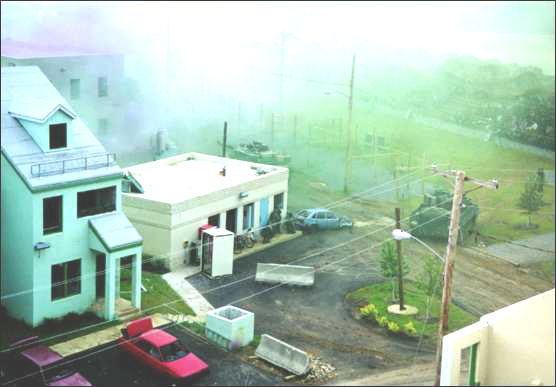 Construction commenced in October 1997 to install the fully instrumented and automated urban combat training site at Fort Knox, Kentucky, and the facility was completed in May 2000. Its formal dedication, viewed by an international audience of military officials and political dignitaries, was held on May 25, 2000. The dedication was followed by a highly realistic, 10 minute-long military force-on-force demonstration, consisting of over 200 soldiers and approximately 12 armored units. (Refer to Photo 1)
Construction commenced in October 1997 to install the fully instrumented and automated urban combat training site at Fort Knox, Kentucky, and the facility was completed in May 2000. Its formal dedication, viewed by an international audience of military officials and political dignitaries, was held on May 25, 2000. The dedication was followed by a highly realistic, 10 minute-long military force-on-force demonstration, consisting of over 200 soldiers and approximately 12 armored units. (Refer to Photo 1)
A deployed-force-in-training at the Zussman facility experiences the total impact of a broad spectrum of urban environments. The city’s 21 structures (intact, as well as battle-impacted), are designed and constructed to resemble facilities found in many urban areas. Structures includes air traffic support facilities, an industrial area, a well developed business area, municipal buildings – including a three-story embassy – a residential area complete with a modern 2-story school, and a complex system of roadways, replete with the normal array of several hundred tons of “combat debris.” The buildings are augmented with facades and are color-coded. Furniture installed in the buildings will trip-up the unwary and hide friend or foe targetry. The normal mixture of ‘urban support’ facilities includes recreational sites such as a subway entrance, a soccer field – large enough to land a helicopter – an open air market, as well as electrical, water, and sewer.
To support a realistic environment, a battery of special effects may be employed, including; a class 100 bridge that can blow-up & burn, five ‘burn-on-command buildings’, ‘on command’ moving and burning cars, ‘on command’ interior and exterior non-toxic smoke, color and sound confusion effects, collapsing and exploding telephone poles with ‘dancing’ electrical lines, a gas station that can blow-up causing a ‘river of fire’ to cross a primary road, as well as wide area and specific point sound effects, and more. Getting very realistic, the sewer system filled with varying depths of ‘dirty water’ – as well as the “little things” normally found in such a place – also links key areas of the city underground. These underground areas can also be “smoked” at a unit commander’s discretion.
The Zussman Mounted Urban Combat Training Site provides a unique learning center for individual and collective technical and tactical skills supporting a successful urban military or para-military deployment, as well as force protection operations. Units with limited training objectives may elect to face a single structure or any mixture of allocated structures. The facility can support four separate company-sized units simultaneously, each with a defined area of operation, or a battalion task force taking on the entire facility.
Performance evaluation is supported by command selection of 10 different video feeds for taping and computer reports provided in either CD-ROM or print-out formats, or staff observations. A high-tech control and command facility (disguised as the town’s water tower), supported by video feeds, computer monitoring stations and a large and detailed mock-up of the facility support a qualified training evaluation.
 The Army Corp. of Engineers managed the construction of the 13.5 million dollar facility and Redstone Arsenal and the Aviation Missile Command was tasked with the instrumentation and software for the facility. NCCIM, a joint venture formed in 1997 between Nichols Research Corporation and COLSA Corporation, both headquartered in Huntsville, Alabama, provided the audio and video systems for the Zussman facility. The gentleman almost solely responsible for the design of the AV systems is NCCIM Senior Systems Analyst, Mark Seeber. (Refer to Photo 2). Ron Galyean, Telecommunications Specialist with NCCIM, is the on-site team leader for the installation of the communications systems.
The Army Corp. of Engineers managed the construction of the 13.5 million dollar facility and Redstone Arsenal and the Aviation Missile Command was tasked with the instrumentation and software for the facility. NCCIM, a joint venture formed in 1997 between Nichols Research Corporation and COLSA Corporation, both headquartered in Huntsville, Alabama, provided the audio and video systems for the Zussman facility. The gentleman almost solely responsible for the design of the AV systems is NCCIM Senior Systems Analyst, Mark Seeber. (Refer to Photo 2). Ron Galyean, Telecommunications Specialist with NCCIM, is the on-site team leader for the installation of the communications systems.
Acoustical Audio Design located in Jeffersonville, Indiana, was the primary certified contractor chosen by Mark Seeber for the project. Innovative Electronic Designs, Inc., of Louisville, Kentucky was contacted by Mark due to their experience in “being able to find solutions to route audio to an infinite amount of zones in convention centers and airports,” states Mark. “I knew they would have the solutions to the obstacles I was going to face in designing Zussman’s audio and video systems. IED worked closely with Acoustical Audio Design into the project since AAD are the local certified contractor.”
THE FRONT END
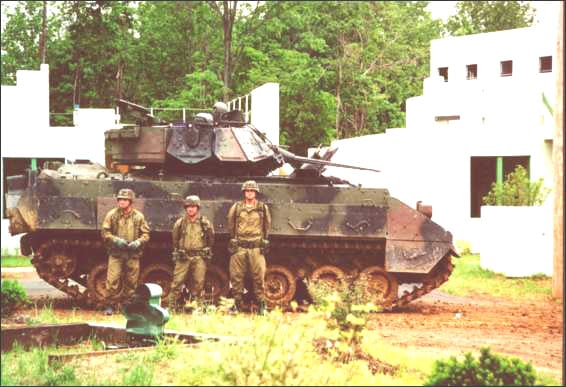 The front end of the system, located in the control tower, is controlled by two software applications, one which operates the audio effects and the second controls the sensors, modular video and targetry throughout every room in every building. Targetry, video cameras and sensors are incredibly modular and are custom installed in each room, as well as around the facility, according to a commander’s training scenario ‘script’. (Refer to Photo 3- a pneumatic pop-up target positioned in the ‘town’s’ traffic circle). Once the aforementioned equipment is installed, the commander can program the complete training scenario from two computer screens in the command center in as little as one hour.
The front end of the system, located in the control tower, is controlled by two software applications, one which operates the audio effects and the second controls the sensors, modular video and targetry throughout every room in every building. Targetry, video cameras and sensors are incredibly modular and are custom installed in each room, as well as around the facility, according to a commander’s training scenario ‘script’. (Refer to Photo 3- a pneumatic pop-up target positioned in the ‘town’s’ traffic circle). Once the aforementioned equipment is installed, the commander can program the complete training scenario from two computer screens in the command center in as little as one hour.
Jeremy Green and Terry Townsend, both programmers with NCCIM, were the gentlemen who toiled for almost a year to create the targetry, video and sensor control software application. Jeremy states, “We’ve created the control application from Wonderware’s In Touch and In Control applications. These are industrial control applications that allow the programmer to customize the software to control large-scale facilities, such as a factory or a jail.”
Jeremy continues, “To design a scenario, you just click on each building from an overview of the city. Once on the view of a building, you can continually click to pull-up the various in-depth views of the floors and rooms. Once in a room, you can select the targets and sensors you need for the scenario, through simple drag-and-drop programming. You drag the target, video, etc., control where you want it, program it for when you want it to come up, go down, and how many kills you want for that target. You can also program any of the video cameras to record for a specific duration of time once a sensor is tripped.”
Jeremy adds, “This control software does not control the flame effects. It does provide us with a ‘Go’/’No Go’ signals for some flame and other effects. The third manual control system was designed so that all flame and other effects are NOT run by software, but by people, so no one gets hurt, or worse, killed.”
The audio control system for the Zussman Mounted Urban Combat Training Site was manufactured by IED and includes IED’s Universal Digital Audio Processing System (UDAPS?). UDAPS is a DSP-based system that provides audio routing, mixing, level control, EQ, delay, announcement distribution, and paging all in the digital domain. The UDAPS for Zussman is sized at 24 X 32, which can dynamically route any one, or a combination, of the 24 input sources to any individual or group of the 32 zone outputs.
The UDAPS delay and DSP functions also provides cross-fading for the fly-around effects and can provide contact closure interface for remote triggering of effects. IED’s UDAPS configuration is controlled by graphical software on the IED 590 Computer System. The custom graphic software package provided by IED allows the user to configure and monitor an entire training scenario, which includes selecting and scheduling the sound effects and choosing the zones to where they will play. The software also provides a DSP probe to audibly listen to any point in the system over the monitor speaker at the computer.
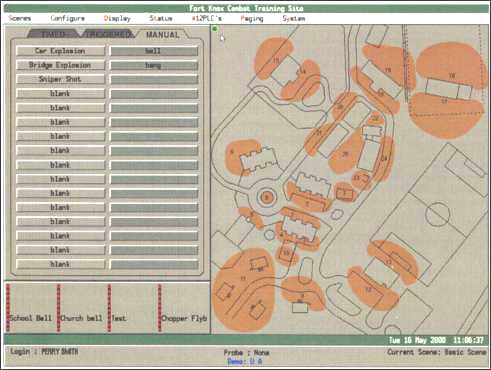 The application displays an overhead view of the site and sound events can be selected for multiple sounds. The user can simply drag-and-drop multiple sound samples into the three ‘run categories’ – Timed, Triggered and Manual – for each specific training event. (Refer to Photo 4).
The application displays an overhead view of the site and sound events can be selected for multiple sounds. The user can simply drag-and-drop multiple sound samples into the three ‘run categories’ – Timed, Triggered and Manual – for each specific training event. (Refer to Photo 4).
Timed sounds are audio events that occur on a regular schedule during a scene, such as a school or church bell ringing, as well as nature and environmental sounds. Eight channels of environmental sound samples – from a three minute helicopter fly-by, to one hour of school children playing, to two hours of nature sounds – can be mixed together and assigned to any zone, or series of zones, to create specific and simultaneous environmental effects for the training exercise.
Triggered sounds, which are tied into the targeting systems, are events that will occur when a sensor provides a contact closure and trigger explosion sound effects. For instance, if the convenience store is ‘blown up and burned’ during an exercise, the program supports that physical effect with audible explosions. Manual “sudden” surprise sounds can be triggered in any zone, at any time, by the system operator while a scene in a training scenario is being played out. Manual events are ‘sudden’, surprise sounds, such as a baby crying, the sound of a machine gun attack, or crowd noises. These manual, ad-libbed, ‘outside-of-the-script’ events are ‘thrown into the scenario’ by the commander to keep his trainees on their toes.
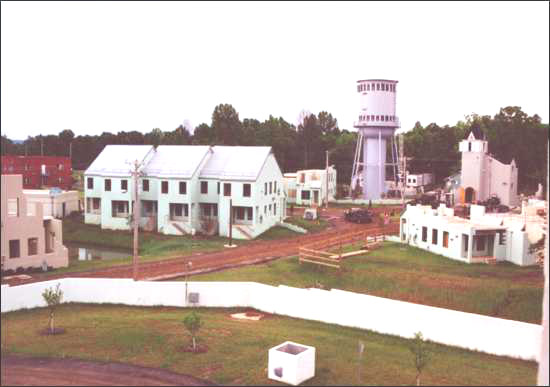 The third, 100% manual control system runs the exploding and pneumatic effects such as the moving and burning cars, collapsing bridge, burn-on-command buildings, and exploding and toppling telephone poles. Obviously, effects which cannot be left to the ‘blind’ run-control of a software application. Even after the software gives a ‘Go’ command, the situation around a manual effect is ‘eye-balled’ and then green-lighted at ‘ground level’ by maneuver observers. The ‘Go commands’ are radioed to the control tower and then the effect is manually triggered. Mark points out, “Multiple approvals need to clear a manual effect to confirm that no troops are in proximity to prevent injury, or even death, from the end result of the effect.” As an extra security precaution, eight remote controlled ‘observer’ video cameras are installed at critical points in the facility. The operator in the control tower controls all pan, tilt and zoom functions while viewing a scenario on eight screens. (Refer to Photo 5).
The third, 100% manual control system runs the exploding and pneumatic effects such as the moving and burning cars, collapsing bridge, burn-on-command buildings, and exploding and toppling telephone poles. Obviously, effects which cannot be left to the ‘blind’ run-control of a software application. Even after the software gives a ‘Go’ command, the situation around a manual effect is ‘eye-balled’ and then green-lighted at ‘ground level’ by maneuver observers. The ‘Go commands’ are radioed to the control tower and then the effect is manually triggered. Mark points out, “Multiple approvals need to clear a manual effect to confirm that no troops are in proximity to prevent injury, or even death, from the end result of the effect.” As an extra security precaution, eight remote controlled ‘observer’ video cameras are installed at critical points in the facility. The operator in the control tower controls all pan, tilt and zoom functions while viewing a scenario on eight screens. (Refer to Photo 5).
TARGETRY, SENSORS AND VIDEO
The facility’s digital interface is completely modular and can be customized for each and every exercise. A tremendous amount of video, light effects, sensor and targetry information can be controlled and routed to and from the command tower via each zone’s Communications (Com) Room. In each of the five Com Rooms, 50 node boxes, each carrying two fibers of information, allows the commander to custom install the aforementioned modular equipment, and then program the computer control of his training areas. Ron states, “We can bring in God knows how much information and route it out to wherever we want.” Each room in every building is ‘wired’ with six pairs of fiber for the installation of targetry, effects and video, while sensors are all permanently installed in each room.
External areas can be as small as an alley to as a large as a street or traffic circle, as well as the sewer and subway systems. Once this equipment is installed, the commander can commence with the scenario programming for the room, building, area, etc.
All sensor information generated from all programmed areas during the course of a training exercise, is fed back to the control tower where it is stored on ten, six gig computer hard drives. Sensor information consists of time the soldier(s) spent in the room to accomplish the mission, shots fired, etc.
 Video is captured for all events in each room and area during a training scenario. (Refer to Photo 6 – one of the many customized, modular cameras installed around the facility). Note the microphone. The foam cube prevents input overload from gun fire and training grenades.) Ron states, “Video cameras are always run on a fiber pair as a primary and secondary, so in case the primary is lost for whatever reason, we always have a back-up video feed. Audio is picked-up at the camera and carried over the video fiber pair, as well. At the Com Room, the information from the cameras is routed to a customized, full audio/video matrix switch, which we call a Knox Switch. The Knox Switch is designed to simultaneously route 32 audio and video sources from the 50 pairs of inputs in each Com Room, back to the control tower and, secondarily, to the closed circuit cable system.” (Refer to Photo 7) The video feed to the cable television system allows viewers to watch everything from each camera, on multiple screens live, as it happens.
Video is captured for all events in each room and area during a training scenario. (Refer to Photo 6 – one of the many customized, modular cameras installed around the facility). Note the microphone. The foam cube prevents input overload from gun fire and training grenades.) Ron states, “Video cameras are always run on a fiber pair as a primary and secondary, so in case the primary is lost for whatever reason, we always have a back-up video feed. Audio is picked-up at the camera and carried over the video fiber pair, as well. At the Com Room, the information from the cameras is routed to a customized, full audio/video matrix switch, which we call a Knox Switch. The Knox Switch is designed to simultaneously route 32 audio and video sources from the 50 pairs of inputs in each Com Room, back to the control tower and, secondarily, to the closed circuit cable system.” (Refer to Photo 7) The video feed to the cable television system allows viewers to watch everything from each camera, on multiple screens live, as it happens.
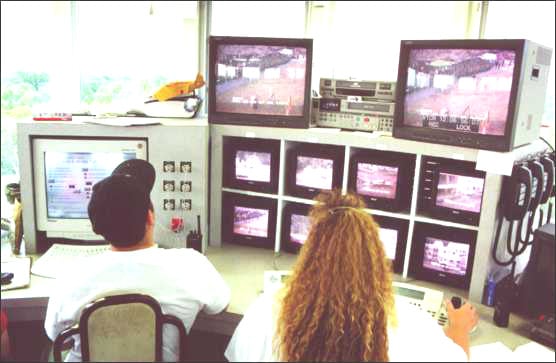 Ron continues, “The primary function of the video system is to record to hard drive, all information generated from each camera. The system allows for detailed recording of all audio and video information and subsequent fast editing capabilities to create an accurate record of the training scenario.”
Ron continues, “The primary function of the video system is to record to hard drive, all information generated from each camera. The system allows for detailed recording of all audio and video information and subsequent fast editing capabilities to create an accurate record of the training scenario.”
During a training scenario, the room or area sensors determine what cameras are going ‘hot’ on the network. The sensor information is routed to the Knox Switch which then routes the 32 audio and video sources to ten video encoders. From the encoders, the video information is then routed to the system’s file structure. The video, as well as the time-line information, is stored in the file structure according to what area the information originated from. In video editing, the video files from the time line are just ‘dragged and dropped’ to create the scenario movie the commander needs to review with his troops. The final edit is either burned to DVD-ROM or VHS tape, or transmitted over the closed circuit cable system to the training review theater.
THE AUDIO
Once the Timed, Triggered and Manual audio effects are programmed into the system and the scenario is set to run, audio is distributed on six channels to each Com Room via miles of fiber runs.
Mark points out, “At the Com Room, the digital audio signal hits the American Fibertek converters and then its cooper out to the loudspeakers. “Input levels and acoustic response is what we needed and American Fibertek was able to produce the product that matched our specs.”
Ron states, “Fiber can be a lot tougher then you might think. But, once you know how to work with and terminate it, fiber is great. The beauty of fiber is you can run fiber lines right up against power lines and have no interference. This place is an RF nightmare. If you could see the RF here, it would look like a fog. You can just tell from our video feed in the tower how nice and sharp it is over the fiber network, it’s really beautiful. If we were unable to use fiber, it would be amazing that we would have any video in this installation.”
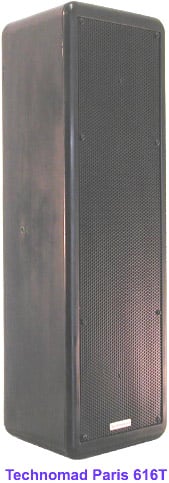 Seventy permanently installed Technomad Paris 616T 70-volt loudspeakers were installed in the 25 exterior audio zones throughout the facility. Almost all of the Paris 616T loudspeakers are installed at the first story level of each building with Allen Products speaker brackets. Mark points out, “At the height at which they are mounted, four Paris speakers can effectively cover an entire street.”
Seventy permanently installed Technomad Paris 616T 70-volt loudspeakers were installed in the 25 exterior audio zones throughout the facility. Almost all of the Paris 616T loudspeakers are installed at the first story level of each building with Allen Products speaker brackets. Mark points out, “At the height at which they are mounted, four Paris speakers can effectively cover an entire street.”
Not only did the Technomad loudspeakers need to be installed fairly high-up on the building for the proper sound coverage, they also had to be out of the range of the exhaust output of many of the armored vehicles, such as an M-1 tank. Mark points out, “When it came to the loudspeaker selection, the weather is the least of my concerns. The diesel exhaust from armored vehicles would kill any less or loudspeaker very quickly. But more so, the heat output from an M-1 tank can melt hair and skin within 8 to 10 feet. It’s a tough environment for all the audio and video gear that is out here, with all the exhaust heat and smoke, compounded with the smoke generated from explosions, flares, smoke grenades and canon fire. The speakers get the worst of it, and I could not find anything else on the market that would endure what the Technomad’s have to go through. Believe me, I looked!”
An additional 16 Technomad Cairo 15/C loudspeakers are utilized in ‘modular interior audio zones’. The high-powered, Crown K2-driven Cairos are installed in close-quarter stairwell and hallway ‘grenade drop’ zones. The Cairo 15/C is bi-amped, 3-way, 1,000 watt Cairo loudspeaker consisting of a 12″ coaxial driver and a 15″ bass transducer. In the Zussman application the Cairos are being run full-range for their various applications. Mark notes, “Since the areas where these speakers are installed are so small, size and output was a critical factory. I could not find anything in the Cairo’s class that could duplicate the SPL output of a close-quarter hand grenade explosion.” Continuing, Mark states, “Since this high-powered explosions are not part of every training scenario, the Technomad Cairos are installed on a ‘need only-basis’, such as when they are installed under the collapsing bridge or in various buildings.”
The K2s were selected to power the Cairo’s grenade drops, “Because,” Mark states, “Since I needed an amp that was going to be left on 24/7, there is nothing to break down on the K2, such as fan.” Continuing, he quips, “The Technomad Cairo and K2 combination just make the sound effects as real as they can get, short of setting off real hand-grenades.”
Comtech 410s and 810s efficiently drive all of the 70 volt Technomad 616T loudspeakers, even in spite of cable runs that are as long as 1,000 feet from each Com Room. Mark notes, “I was concerned that with these long cable runs, we were going to have to add more power or install fewer speakers; you have to do whatever you can go balance it. But, the Comtechs proved to be very efficient for the application.” Continuing, Mark notes, “The system is incredibly quiet. It’s powered-on all the time and there is no hiss or hum at all.”
Mark adds, “The playback is very life-like, therefore very effective. In one demonstration, I was playing a mixed combination of vehicles and machinery, crowd noises such as multiple conversations and people milling about, as well as a significant amount of nature sounds, birds, wind, what-have-you. I walked a large part of the facility with several commanders who commented they couldn’t hear the audio program, just all the aforementioned background noise. Then I stopped the audio program and there was nothing, no noise at all. Zussman is easily four or more miles from the nearest country road, so when you’re out here alone, there is no civilization background noise all at, just the occasional bird or maybe the wind. I, essentially, had the commanders psychologically convinced that a lot was happening out here, until I shut it all off. That was a very effective demonstration to the commanders as to the accuracy of the playback system.”
THE MINOR DETAILS
Roland AR2000s were installed for random playback messages consisting of, up to, two hours of FM radio stations, as well as telephone transmissions. Mark points out, “The FM radio station recordings, for one such scenario, were various repeating Russian broadcasts, which were actually recorded from radio stations in Kosovo. The broadcasts are transmitted within the facility and are all part of the scenario, if part of the training is to monitor enemy radio broadcasts, especially if Army Intelligence is involved in the training.”
Making the scenarios even more realistic, additional AR2000s are tied into the facility-wide telephone network. Mark continues, “I can store up to 250 messages on a single AR2000 PC card. These messages can be as varied as a dial tone, someone dialing, static, a conversation in who-knows-what language, and so on. For whatever reason an individual in training needs to pick-up a phone – keep in mind, FBI, CIA, and police forces will train here – we can have various pre-recorded telephone noise or conversations going on as part of the scenario. A contact closure starts another random message whenever a receiver is picked-up.”
Mark states, “The Zussman facility represents the state-of-the-art in systems designing for operation and control simplicity. When the project was still on the drawing board, a few executives visited the talent at the leading amusement parks, such as Universal and Disney. They wanted to investigate how they created their attractions and what technology is used to pull-off such realism, even though none of Universal’s or Disney’s attraction technology was incorporated in the finished Zussman training facility.” Concluding, Mark quips, “Though the public will never be allowed to participate in any event here at Zussman, I can assure anyone, we have both Universal and Disney beat in the realism department.”

